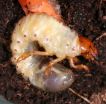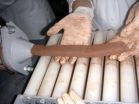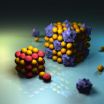(Press-News.org) Researchers at the RUB and from the MPI Dortmund have uncovered the mechanism that
switches off the cell transport regulating proteins. They were able to resolve in detail how the central switch protein Rab is down-regulated with two "protein fingers" by its interaction partners. The structural and dynamic data is reported by the researchers led by Prof. Dr. Klaus Gerwert (Chair of Biophysics, RUB) and Prof. Dr. Roger S. Goody (Max Planck Institute for Molecular Physiology, Dortmund, Germany) in the Online Early Edition of the journal PNAS. "Unlike in the cell growth protein Ras, which is regulated with only one 'finger', we have surprisingly found a two-finger switch-off mechanism in Rab. This throws a completely new light on the functioning of certain enzymes, the small GTPases, to which Rab belongs", Klaus Gerwert explains.
Switch proteins associated with various diseases
Unlike Ras proteins that regulate cell growth, Rab GTPases (also called Rab proteins) control various transport operations between different areas of a cell. If the transport system is disrupted, diseases such as obesity can occur. The Rab proteins work as a switch, just like the Ras proteins. In the "on" state, the high-energy molecule GTP is bound, in the "off" state, the lower-energy GDP. The cleavage of GTP to GDP is catalysed by the so-termed RabGAP proteins. In so doing, GTP is split into GDP and phosphate. The research team observed the underlying reaction in time and space for the first time with the highest possible atomic resolution.
First a snapshot, then a whole film
Using X-ray structure analysis, the researchers first determined the spatial structure of the protein complex. The data showed a finger of the amino acid arginine, and a second finger of glutamine. The arginine finger was already known from Ras. The glutamine finger is new and surprising. RabGAP penetrates into the GTP-binding pocket of Rab with both fingers and accelerates the GTP cleavage over five orders of magnitude. The biophysicists observed this dynamic process in real time using FTIR spectroscopy. "In contrast to X-ray structure analysis, FTIR spectroscopy not only gives us a snapshot of the reaction, but an entire film", says PD Dr. Carsten Kötting. The result: both catalytic fingers penetrate simultaneously into the GTP-binding pocket and leave it with the phosphate cleaved from the GTP.
Medically interesting mechanism
In their experiment, the researchers examined the protein Rab1b and the RabGAP TBC1D20. Other Rab proteins and RabGAPs are similar to these two representatives. "Thus, we assume that they also interact via a two-finger mechanism", Konstantin Gavriljuk speculates. The ability of the two-finger system to also switch off mutated Rab proteins, i.e. mutated GTPases, could also be medically very interesting. It would be conceivable to develop small molecules that mimic the two-finger mechanism, and thus switch off other mutant GTPases, such as Ras, which emit uncontrolled growth signals and thus are involved in tumour formation.
###
Bibliographic record
K. Gavriljuk, E.-M. Gazdag, A. Itzen, C. Kötting, R.S. Goody, K. Gerwert (2012): Catalytic mechanism of a mammalian Rab•RabGAP complex in atomic detail, PNAS, DOI: 10.1073/pnas.1214431110
Further information
Prof. Dr. Klaus Gerwert
Department of Biophysics
Faculty of Biology and Biotechnology at the Ruhr-Universität
44780 Bochum, Germany
Figure online
A figure related to this press release can be found online at: http://aktuell.ruhr-uni-bochum.de/pm2012/pm00416.html.en
Click for more
Department of Biophysics
Previous press release on cell growth protein Ras
Editor: Dr. Julia Weiler
Fast-acting enzymes with 2 fingers: Protein structurally and dynamically explained
Researchers at the RUB and from the MPI Dortmund investigate small GTPases
2012-12-19
ELSE PRESS RELEASES FROM THIS DATE:
Badger sleeping habits could help target TB control
2012-12-19
Scientists found that badgers which strayed away from the family burrow in favour of sleeping in outlying dens were more likely to carry TB.
The 12-month study of 40 wild badgers was funded by the Department for Environment, Food and Rural Affairs (Defra) and could have implications for the management of bovine TB in parts of the UK. The behaviour of individual animals is thought to be a key factor in how the disease is spread among animals and livestock. The new findings could help to understand and develop measures to manage TB in badgers.
The study is published ...
The role of the innate immune cells in the development of type 1 diabetes
2012-12-19
The researchers reveal the role of the innate immune cells, especially the dendritic cells, that cause the activation of the killer T-lymphocytes whose action is directed against the p pancreatic cells. The results obtained in mice make it possible to consider new ways of regulating the auto-immune reaction generated by the innate immune cells.
Type 1 diabetes, or insulin-dependent diabetes, is an auto-immune disease characterised by the destruction of insulin-producing pancreatic β cells that are present in the Islets of Langerhans which are themselves in the pancreas. ...
Not without my microbes
2012-12-19
Apart from the common European cockchafer (Melolontha melolontha), the European forest cockchafer (Melolontha hippocastani) is the most common species of the Melolontha genus. These insects can damage huge areas of broadleaf trees and conifers in woodlands and on heaths. Cockchafers house microbes in their guts that help them to digest their woody food, such as lignocelluloses and xylans. Scientists of the Max Planck Institute for Chemical Ecology in Jena, Germany, have now performed comprehensive RNA analyses and identified the microbiota of cockchafer larvae feeding on ...
Scale-up of a temporary bioartificial liver support system described in BioResearch Open Access
2012-12-19
New Rochelle, NY, December 19, 2012—Acute liver failure is usually fatal without a liver transplant, but the liver can regenerate and recover if given time to heal. A bioartificial liver machine that can provide temporary support while organ regeneration takes place has been scaled up for testing in a large animal model and is described in an article in BioResearch Open Access, a bimonthly peer-reviewed open access journal from Mary Ann Liebert, Inc., publishers. The article is available on the BioResearch Open Access website .
A team of researchers from University College ...
When the ice melts, the Earth spews fire
2012-12-19
In 1991, it was a disaster for the villages nearby the erupting Philippine volcano Pinatubo. But the effects were felt even as far away as Europe. The volcano threw up many tons of ash and other particles into the atmosphere causing less sunlight than usual to reach the Earth's surface. For the first few years after the eruption, global temperatures dropped by half a degree. In general, volcanic eruptions can have a strong short-term impact on climate. Conversely, the idea that climate may also affect volcanic eruptions on a global scale and over long periods of time is ...
Paper waste used to make bricks
2012-12-19
Researchers at the University of Jaen (Spain) have mixed waste from the paper industry with ceramic material used in the construction industry. The result is a brick that has low thermal conductivity meaning it acts as a good insulator. However, its mechanical resistance still requires improvement.
"The use of paper industry waste could bring about economic and environmental benefits as it means that material considered as waste can be reused as raw material." – This is one of the conclusions of the study developed by researchers at the Upper Polytechnic School of Linares ...
New dynamic dual-core optical fiber enhances data routes on information superhighway
2012-12-19
Optical fibers –the backbone of the Internet–carry movies, messages, and music at the speed of light. But for all their efficiency, these ultrathin strands of pristine glass must connect to sluggish signal switches, routers, and buffers in order to transmit data. Hoping to do away with these information speed bumps, researchers have developed a new, dual-core optical fiber that can perform the same functions just by applying a miniscule amount of mechanical pressure.
These new nanomechanical fibers, which have their light-carrying cores suspended less than 1 micrometer ...
Cholesterol helps regulate key signaling proteins in the cell
2012-12-19
Cholesterol plays a key role in regulating proteins involved in cell signaling and may be important to many other cell processes, an international team of researchers has found.
The results of their study are reported in the journal Nature Communications.
Cholesterol's role in heart disease has given it a bad reputation. But inside the thin membrane of a cell, the tight regulation of cholesterol at high levels (30 to 40 percent) suggests that it plays an important role in cellular processes, says Wonhwa Cho, professor of chemistry at the University of Illinois at Chicago ...
Synthetic and biological nanoparticles combined to produce new metamaterials
2012-12-19
Scientists from Aalto University, Finland, have succeeded in organising virus particles, protein cages and nanoparticles into crystalline materials. These nanomaterials studied by the Finnish research group are important for applications in sensing, optics, electronics and drug delivery.
Layer structures, or superlattices, of crystalline nanoparticles have been extensively studied in recent years. The research develops hierarchically structured nanomaterials with tuneable optical, magnetic, electronic and catalytic properties.
Such biohybrid superlattices of nanoparticles ...
Community togetherness plays vital role in coping with tragedies
2012-12-19
Community solidarity and support have remarkable benefits for people coping with traumatic mass shootings, according to an American-Finnish research study recently published by the University of Turku.
James Hawdon and John Ryan, both professors of sociology at Virginia Tech, with Finnish researchers Atte Oksanen and Pekka Räsänen, investigated the responses of four communities that suffered from similar tragedies in the United States and Finland.
People in all four communities expressed their need for belonging after the shootings, and this solidarity appeared to ...
LAST 30 PRESS RELEASES:
What causes some people’s gut microbes to produce high alcohol levels?
Global study reveals widespread burning of plastic for heating and cooking
MIT study shows pills that communicate from the stomach could improve medication adherence
Searching for the centromere: diversity in pathways key for cell division
Behind nature’s blueprints
Researchers search for why some people’s gut microbes produce high alcohol levels
Researchers find promising new way to boost the immune response to cancer
Coffee as a staining agent substitute in electron microscopy
Revealing the diversity of olfactory receptors in hagfish and its implications for early vertebrate evolution
Development of an ultrasonic sensor capable of cuffless, non-invasive blood pressure measurement
Longer treatment with medications for opioid use disorder is associated with greater probability of survival
Strategy over morality can help conservation campaigns reduce ivory demand, research shows
Rising temperatures reshape microbial carbon cycling during animal carcass decomposition in water
Achieving ultra-low-power explosive jumps via locust bio-hybrid muscle actuators
Plant-derived phenolic acids revive the power of tetracycline against drug-resistant bacteria
Cooperation: A costly affair in bacterial social behaviour?
Viruses in wastewater: Silent drivers of pollution removal and antibiotic resistance
Sub-iethal water disinfection may accelerate the spread of antibiotic resistance
Three in four new Australian moms struggle with body image
Post-stroke injection protects the brain in preclinical study
Cardiovascular risk score predicts multiple eye diseases
Health: estimated one in ten British adults used or interested in GLP-1 medications for weight loss
Exercise to treat depression yields similar results to therapy
Whooping cough vaccination for pregnant women strengthens babies’ immune system
Dramatic decline in new cases of orphanhood in Uganda driven by HIV treatment and prevention programs
Stopping weight loss drugs linked to weight regain and reversal of heart health markers
Higher intake of food preservatives linked to increased cancer risk
Mass General Brigham–developed cholera vaccine completes phase 1 trial
First experimental validation of a “150-year-old chemical common sense” direct visualization of the molecular structural changes in the ultrafast anthracene [4+4] photocycloaddition reaction
Lack of support for people on weight loss drugs leaves them vulnerable to nutritional deficiencies, say experts
[Press-News.org] Fast-acting enzymes with 2 fingers: Protein structurally and dynamically explainedResearchers at the RUB and from the MPI Dortmund investigate small GTPases




